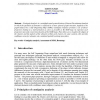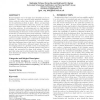183 search results - page 2 / 37 » Analyzing graph structure via linear measurements |
NETWORKS
2008
13 years 5 months ago
2008
In a problem arising in grooming for two-period optical networks, it is required to decompose the complete graph on n vertices into subgraphs each containing at most C edges, so t...
NN
2006
Springer
13 years 5 months ago
2006
Springer
- Contiguity Analysis is a straightforward generalization of Linear Discriminant Analysis in which the partition of elements is replaced by a more general graph structure. Applied ...
CORR
2010
Springer
13 years 3 months ago
2010
Springer
Gaussian graphical models are of great interest in statistical learning. Because the conditional independencies between different nodes correspond to zero entries in the inverse c...
WWW
2008
ACM
14 years 6 months ago
2008
ACM
We analyze dependencies in power law graph data (Web sample, Wikipedia sample and a preferential attachment graph) using statistical inference for multivariate regular variation. ...
GECCO
2009
Springer
13 years 12 months ago
2009
Springer
Hyper-heuristics can be thought of as “heuristics to choose heuristics”. They are concerned with adaptively finding solution methods, rather than directly producing a solutio...


